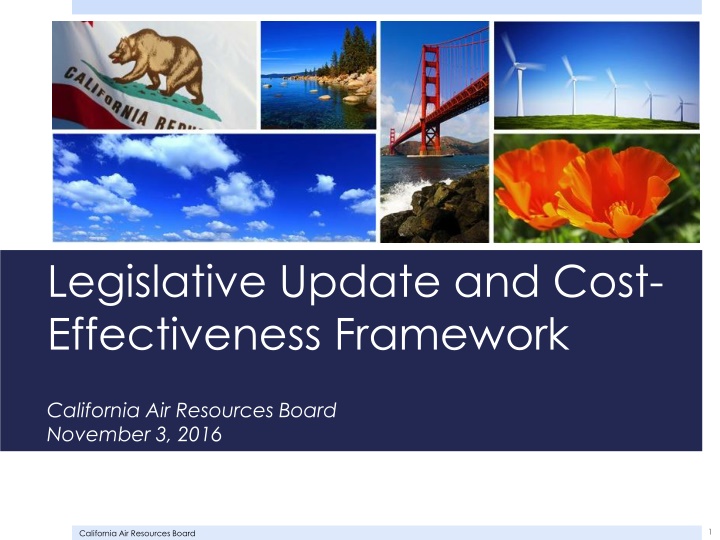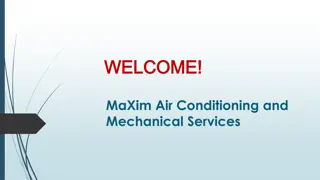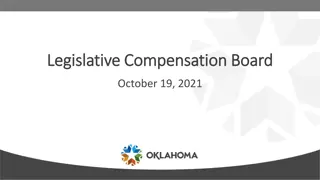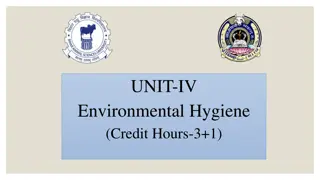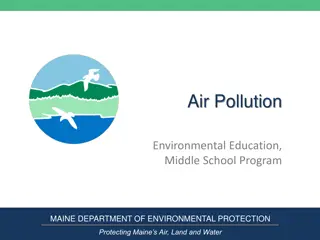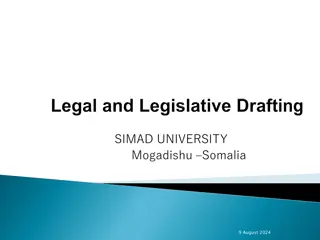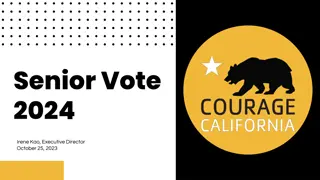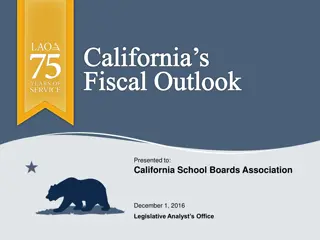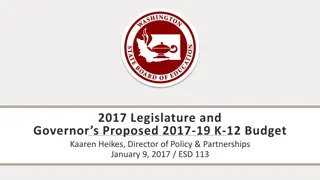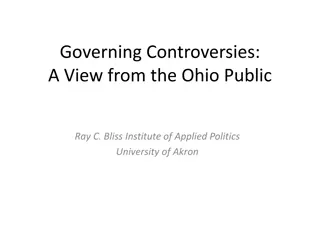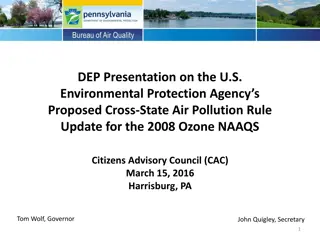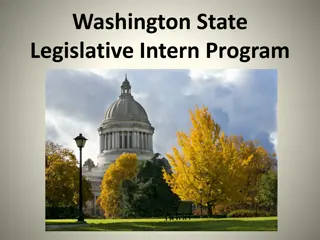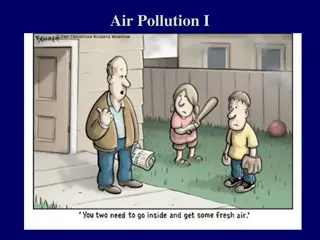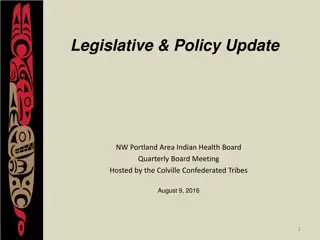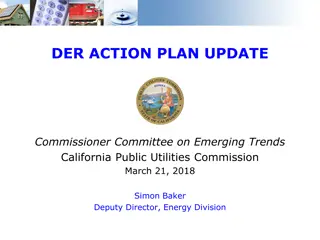Update on California Air Resources Board Legislative Framework
California Air Resources Board's legislative update focuses on cost-effectiveness, greenhouse gas targets, and measures for reducing short-lived climate pollutants and natural gas emissions. The framework outlines plans, targets, and strategies to achieve emission reductions and promote environmentally sustainable practices in the state.
Download Presentation

Please find below an Image/Link to download the presentation.
The content on the website is provided AS IS for your information and personal use only. It may not be sold, licensed, or shared on other websites without obtaining consent from the author.If you encounter any issues during the download, it is possible that the publisher has removed the file from their server.
You are allowed to download the files provided on this website for personal or commercial use, subject to the condition that they are used lawfully. All files are the property of their respective owners.
The content on the website is provided AS IS for your information and personal use only. It may not be sold, licensed, or shared on other websites without obtaining consent from the author.
E N D
Presentation Transcript
Legislative Update and Cost- Effectiveness Framework California Air Resources Board November 3, 2016 1 California Air Resources Board
Outline Legislative Update Cost-Effectiveness Definition Types of costs Considerations Social Costs Definition Application in California California's 2030 Target Scoping Plan 2 California Air Resources Board
Greenhouse Gas Targets AB 32 Sets 2020 emissions limit and requires Scoping Plan to outline how the limit will be achieved EO B-30-15 Establishes midterm GHG emissions reduction target of 40% below 1990 levels by 2030; Updates AB 32 Scoping Plan to incorporate the 2030 GHG target. SB 32 Codifies 2030 midterm GHG target. AB 197 Prioritizes measures resulting in direct emissions reduction while considering cost effectiveness and minimizing emissions leakage. 4
SB 1383 Short-Lived Climate Pollutants ARB must approve and begin implementing the comprehensive SLCP strategy by Jan 2018 Achieves 2030 reduction targets: 40 % reduction in methane emissions below 2013 levels; 40% reduction in hydrofluorocarbon emissions below 2013 levels; 50% reduction in black carbon emissions below 2013 levels; 50% reduction in disposal of organics below 2014 levels by 2020 & 75% reduction by 2025. Prioritizes production and utilization of renewable natural gas 5
SB 1371 Natural Gas Directs CPUC, in consultation with ARB, to: Adopt rules & procedures to minimize NG leaks from transmission & distribution pipelines; Reduce emissions to the maximum extent technologically feasible & cost effective Require gas corporations to file a report on leak management practices, new leaks by grade, leaks being monitored, and gas loss estimate; and Establish BPs for leak survey technology, patrols, and leak prevention & reduction. ARB retains authority to adopt rules and regulations to further achieve emission reductions. 6
SB 887 Natural Gas Storage Wells Directs ARB, with local air districts and DOGGR, to: Develop a monitoring program that requires storage facilities to submit monitoring plans that include continuous air monitoring with data publicly available. Requires Operators to: Commence mechanical integrity testing by Jan 1, 2018, specified by the DOGGR; and Submit a risk management plan, including a protocol for public notice of a large/uncontrollable leak and mitigation efforts. Directs DOGGR to: Establish standards for well design, construction, and maintenance; Perform unannounced annual random onsite inspections; and Determine, in consultation with ARB, what constitutes a reportable leak. 7
SB 888 Gas Corporations Mandates CPUC, in consultation with ARB, to: Assess a monetary penalty to fully offset the GHG impacts of a NG storage facility leak as determined by ARB; Deposit the penalty to the Gas Storage Facility Leak Mitigation Account with the State Treasury; and Expend the money as appropriated by the Legislature for direct GHG emissions reduction. Establishes the Office of Emergency Services (OES) as the lead agency for response to NG leak from a storage facility Requires OES to coordinate responses, public health, environmental assessment, monitoring, and long term management and control of the leak. 8
AB 1496 Methane Emissions Requires ARB, in consultation with state, local, federal agencies and independent scientific experts, to: Undertake monitoring & measurements of high-emissions methane hot spots ; Conduct lifecycle GHG emission analysis of NG produced in and imported into the state; Update relevant policies and programs to incorporate the information gathered above; and Review the most up-to-date data on methane reactivity as a precursor for ground ozone formation. 9
Cost-Effectiveness and Social Costs 10
Cost-Effectiveness AB 32 and SB 1371 maximum technologically feasible and cost- effective AB 32 definition Cost per unit of reduced emissions of greenhouse gases adjusted for global warming potential How is the scope of the costs defined? Over what time period is are the costs measured? 11 California Air Resources Board
Costs in Economic Impact Assessments Direct regulatory costs The costs to a directly regulated party that result from compliance with a regulation or standard Include costs associated with changes in equipment, fuel, and energy expenditures and demand, and infrastructure costs Macroeconomic costs The costs to the overall economy of meeting a regulation or standard Includes direct, indirect, and induced impacts Provides estimates of impact to GDP, employment, industrial sectors, and individuals 12 California Air Resources Board
Social Cost Direct (or private) costs Individuals often consider only their costs when making decisions, not the costs that might be incurred by others Social cost is defined as the total cost to society Includes the costs to individuals and any external costs that the decisions of individuals may impose on others in the society 13 California Air Resources Board
US EPA Definition of Social Cost From a regulatory standpoint, social cost represents the total burden a regulation will impose on the economy. It can be defined as the sum of all opportunity costs incurred as a result of the regulation. These opportunity costs consist of the value lost to society of all the goods and services that will not be produced and consumed if firms comply with the regulation and reallocate resources away from production activities and towards pollution abatement. 14 California Air Resources Board
US EPA Social Cost continued To be complete, an estimate of social cost should include both the opportunity costs of current consumption that will be foregone as a result of the regulation, and also the losses that may result if the regulation reduces capital investment and thus future consumption. 15 California Air Resources Board
Social Cost Consideration in Statute AB 32 (2006) Consider overall societal benefits, including reductions in other air pollutants, diversification of energy sources, and other benefits to the economy, environment, and public health AB 197 (2016) Consider the social costs of the emissions of greenhouse gases Defined as: an estimate of the economic damages, including but not limited to, changes, in net agricultural productivity; impacts to public health; climate adaption impacts, such as property damages from increased flood risk; and changes in energy system costs, per metric ton 16 California Air Resources Board
Social Cost of Carbon (SC-CO2) An estimate of the economic damages associated with a one metric ton increase in CO2in a given year Represents the value of damages avoided for a one metric ton reduction in CO2 Includes impacts to: Agricultural productivity Human health Property damages from increased flood risk Changes in energy system costs Does not include economic impacts of co-pollutants or impacts that cannot be accurately monetized 17 California Air Resources Board
Social Cost of Carbon in Use US EPA has used SC-CO2 in rulemakings since 2010 GHG vehicle standards Toxic air pollutant rulemakings Intergovernmental Panel of Climate Change (IPCC)includes SC-CO2 in estimating climate impacts Public Utility Commissions Minnesota formally adopted SC-CO2 for integrated resource Planning Massachusetts requires valuation of CO2 and other air pollutants in integrated resource planning New York is using the SC-CO2 in clean energy planning 18 California Air Resources Board
SC-CO2 (2007$/metric ton) 3% 95th Emission Year 2.5% Average 5% Average 3% Average Percentile 2015 $11 $36 $56 $105 2020 $12 $42 $62 $123 2025 $14 $46 $68 $138 2030 $16 $50 $73 $152 ? Source: Technical Update of the Social Cost of Carbon for Regulatory Impact Analysis Under Executive Order 12866, Interagency Working Group on Social Cost of Carbon, United States Government, (May 2013, Revised July 2015). 19 California Air Resources Board
Social Cost of Methane (SC-CH4) An estimate of the economic damages associated with a one metric ton increase in methane in a given year Includes impacts to: Agricultural productivity Human health Property damages from increased flood risk Changes in energy system costs Impacts are specific to methane emissions Does not include economic impacts of co-pollutants US EPA uses in sensitivity analyses and in the 2015 Regulatory Impact Analysis of the Proposed Emission Standards for New and Modified Sources in the Oil and Natural Gas Sector 20 California Air Resources Board
SC-CH4 (2012$/metric ton) Emission Year 2.5% Average 3% 95th Percentile 5% Average 3% Average 2015 2030 $490 $820 $1,100 $1,700 $1,500 $2,200 $3,000 $4,500 ? Source: U.S. Environmental Protection Agency, Regulatory Impact Analysis of the Proposed Emission Standards for New and Modified Sources in the Oil and Natural Gas Sector, EPA-452/R-15-002, August 2015 21 California Air Resources Board
2030 Target Scoping Plan Outlines social cost methodology and defines the US EPA SC-CO2 Identifies uncertainties, data limitations, and evolving modeling Incorporates the concept of SC-CO2 Presents the range of the economic benefits that occur as a result of the avoided environmental damage that results from achieving the 2030 target Utilizes the SC-CO2 values in a potential path (carbon tax) to achieve the 2030 target 22 California Air Resources Board
Contact Information Emily Wimberger Chief Economist emily.wimberger@arb.ca.gov Elizabeth Scheehle Branch Chief, Oil and Gas and Greenhouse Gas Mitigation elizabeth.scheehle@arb.ca.gov Winardi Setiawan Specialist, Oil and Gas and Greenhouse Gas Mitigation winardi.setiawan@arb.ca.gov 23 California Air Resources Board
